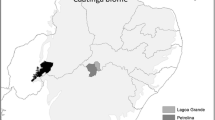Abstract
The coypu (Myocastor coypus), a rodent whose natural habitat is stagnant freshwater, has become a widespread pest in France within the last decade. This study investigated the prevalence of seropositivity and the renal carriage of leptospires in coypus in order to evaluate their role in terms of the risk of infection by Leptospira interrogans in domestic animals and humans. The study involved the application of serological and bacteriological methods to identify leptospires infection and/or carriage in 738 coypus trapped from 1996 to 1999 in six areas of France. Seroprevalence in samples ranged from 16.5 to 66%, and three field strains were isolated (two L. interrogans Icterohaemorrhagiae and one L. interrogans Sejroe). This first report on the isolation of leptospires from coypus in France emphasises the role of this animal in the epidemiology of leptospirosis.
Similar content being viewed by others
References
Levett PN, Walton D, Waterman LD, Whittington CU, Mathison GE, Edwards COR. Surveillance of leptospiral carriage by feral rats in Barbados. West Indian Med J 1998; 47(1): 15–17.
Carter ME, Cordes DO. Leptospirosis and other infections of Rattus rattus and Rattus norvegicus. NZ vet J 1980; 28: 45–50.
Dalu JM, Feresu SB. Domestic rodents as reservoir of pathogenic Leptospira on two city of Harare farms: Preliminary results of bacteriological and serological studies. Belg J Zool 1997; 127: 105–112.
Kuiken T, van Dijk JE, Terpstra WJ, Bokhout BA. The role of the common vole (Microtus arvalis) in the epidemiology of bovine infection with Leptospira interrogans serovar hardjo. Vet Microbiol 1991; 28: 353–361.
Steinen ACM, Schuurman JL, Grave kamp C, Korver H, Terpstra WL. Muskrats as carriers of pathogenic leptospires in the Netherlands. Antonie van Leeuwenhoek 1992; 61: 43–50.
André-Fontaine G, Ganière JP. New topics on leptospirosis. Comp Immun Microbiol Infect 1990; 13(3): 163–168.
André-Fontaine G, Ganière JP, Boukerrou A, Quiniou MA. Comparaison des prévalences des anticorps antileptospires entre un échantillon de vaches ayant avorté et un échantillon tiré au sort en Loire Atlantique. Epidémiol Santé anim 1987; 11: 53–63.
Jouventin P, Micol T, Verheyden C, Guédon G. Le Ragondin: Biologie et Méthodes de Limitation des Populations. Paris: Association de Coordination Technique Agricole. 1996.
Anchezar BV, Illa R, Vivoli D. La nutria fuente de la enfermedad de Weil por Leptospira bonariensis. Rev Inst Bact 1949; 14: 114–123.
Waitkins SA, Wanyangu S, Palmer M. The coypu as a rodent reservoir of Leptospira infection in Great Britain. J Hyg Camb 1985; 95: 409–417.
Wanyangu SW, Waitkins SA, Palmer MF. Isolation of leptospires from a one week dead coypu (Myocastor coypus molina). Int J Zoon 1986; 13: 236–240.
Faine S, Adler B, Bolin C, Perolat P. Leptospira and Leptospirosis. Melborne: MediSci 1999.
Herrmann JL, Baril C, Bellenger E, Perolat P, Baranton G, Saint Girons I. Genome conservation in isolates of Leptospira interrogans. J Bact 1991; 173(23): 7582–7588.
Trap D. Small mammals as a source of leptospirosis. Rev Sci Tech Off Int Epiz 1988; 7(4): 893–899.
Le Grand D, Solsona M, Rosengarten R, Poumarat F. Adaptative surface antigen variation in Mycoplasma bovis to the host immune response. FEMS Microbiol Lett 1996; 144(2–3): 267–275.
Gorelova ND, Bellenger E, Postic D, Kovalevskii Iuv. Spontaneous mixed infection in rodents with Borrelia and Leptospira. Med Parazitol 1996; 4: 53.
Doncaster P, Jouventin P. Les ragondins. La recherche 1989; 20(211): 754–761.
Chernukha IuG, Boroznov NI, Anan'ina IuV. Populations of pathogenic Leptospira of varying virulence in nature. Zh Mikrobiol Epidemiol Immunobiol 1988; Aug (8): 13–16.
Greig A, Stevenson K, Henderson D, Perez V, Hughes V, Pavlik I, et al. Epidemiological study of Paratuberculosis in wild rabbits in Scotland. J Clin Microbiol 1999; 37(6): 1746–1751.
Hathaway SC, Ellis WA, Little TWA, Stevens AE, Ferguson HW. Leptospira interrogans serovar hardlo in pigs: A new host-parasite relationship in the United Kingdom. Vet Rec 1983; 113: 153–154.
Bolin CA, Zuerner RL. Correlation between DNA Restriction Fragment Length Polymorphisms in Leptospira interrogans serovar pomona type kennewicki and host animal source. J Clinical Microbiol 1996; 34(2): 424–425.
Baranton G, Postic D. Centre national de Référence des Leptospires: Rapport Annuel D'activité 1999. Paris, 1999.
André-Fontaine G, Harousseau H, Ganière JP, Quiniou MA. Leptospirose: Prévalence sérologique chez des donneurs de sang. Méd Mal Infect 1988; 12: 877–880.
André-Fontaine G, Peslerbe X, Ganière JP. Occupational hazard of unnoticed leptospirosis in water ways maintenance staff. Eur J Epidemiol 1992; 8(2): 228–232.
Michault A. Insularité et risques épidémiques á la Réunion. Bull Soc Path Exot 1998; 91(1): 52–55.
Perrocheau A, Perolat P. Epidemiology of leptospirosis in New Caledonia (South Pacific): A one-year survey. Eur J Epid 1997; 13: 161–167.
Schillinger F, Babeau N, Montagnac R, Milcent T. Les formes rénales graves de la leptospiroses. A propos de six cas receuillis en quinze ans dans un même service. Néphrologie 1999; 20: 81–86.
Ciceroni L, Stephan Erminia, Pinto A, Pizzacaro P, Dettori G, Franzin L, et al. Epidemiological trend of human leptospirosis in Italy between 1994 and 1996. Eur J Epidemiol 2000; 16: 79–86.
Kuriakose M, Eapen CK, Paul R. Leptospirosis in Kolenchery, Kerala, India: Epidemiology, prevalent local serogroups and serovars and a new serovar. Eur J Epid 1997; 13: 691–697.
Levett PN. Leptospirosis: Re-emerging or re-discovered disease? J Med Microbiol 1999; 48: 417–418.
Maghami GH, Hooshmand-rad P, Farhang-Azad A. Leptospirosis in small mammals of Iran: isolation of Leptospira grippotyphosa from Mus musculus. J Wildl Dis 1977; 13: 286–289.
Bovet P, Yersin C, Merien F, Davis CE, Perolat P. Factors associated with clinical leptospirosis: a population-based case-control study in the Seychelles (Indian Ocean). Int J Epid 1999; 28: 583–590.
Dalu JM, Feresu SB. Domestic rodents as reservoirs of pathogenic Leptospira on two city of harare farms: Preliminary results of bacteriological and serological studies. Belg J Zool 1997; 127: 105–112.
Author information
Authors and Affiliations
Rights and permissions
About this article
Cite this article
Michel, V., Ruvoen-Clouet, N., Menard, A. et al. Role of the coypu (Myocastor coypus) in the epidemiology of leptospirosis in domestic animals and humans in France. Eur J Epidemiol 17, 111–121 (2001). https://doi.org/10.1023/A:1017931607318
Issue Date:
DOI: https://doi.org/10.1023/A:1017931607318




